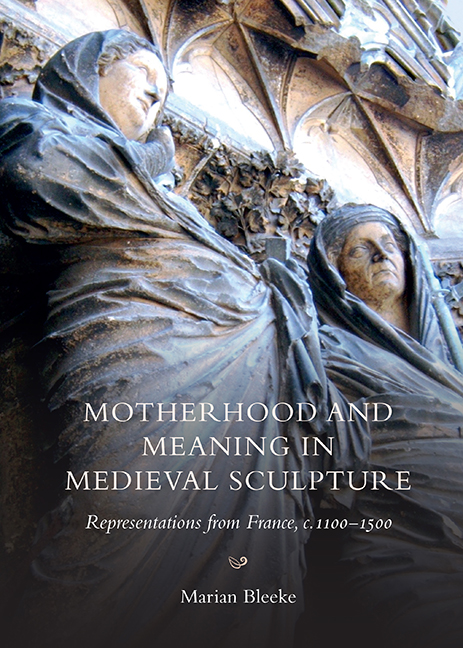Book contents
- Frontmatter
- Contents
- List of Illustrations
- Acknowledgments
- Introduction: Motherhood and Meaning in Medieval Sculpture
- 1 Motherhood as Transformation: From Annunciation to Visitation at Reims
- 2 Motherhood as Monstrosity: The Moissac Femme-aux-serpents and the Transi of Jeanne de Bourbon-Vendôme
- 3 Resurrecting Lazarus: The Eve from Saint-Lazare at Autun
- 4 Visualizing Parturition: Devotional Sculptures of the Virgin and Child
- Afterword: Motherhood and Meaning: Medieval Sculpture and Contemporary Art
- Bibliography
- Index
- Already Published
1 - Motherhood as Transformation: From Annunciation to Visitation at Reims
Published online by Cambridge University Press: 29 May 2021
- Frontmatter
- Contents
- List of Illustrations
- Acknowledgments
- Introduction: Motherhood and Meaning in Medieval Sculpture
- 1 Motherhood as Transformation: From Annunciation to Visitation at Reims
- 2 Motherhood as Monstrosity: The Moissac Femme-aux-serpents and the Transi of Jeanne de Bourbon-Vendôme
- 3 Resurrecting Lazarus: The Eve from Saint-Lazare at Autun
- 4 Visualizing Parturition: Devotional Sculptures of the Virgin and Child
- Afterword: Motherhood and Meaning: Medieval Sculpture and Contemporary Art
- Bibliography
- Index
- Already Published
Summary
The two female figures stand shoulder to shoulder but also back to back (Fig. 2). Their close spatial juxtaposition combined with their mutual lack of recognition calls attention to the striking differences in their forms. The woman on the left stands upright, aside from a slight forward movement of her head, whereas the woman on the right stands in a version of the classical contrapossto pose; her right knee bent, her left hip and abdomen extended out to the side, her upper torso shifted away from that hip – a shift accentuated by her extended right elbow – and her head tilted back to the left. The women's draperies further accentuate these differences in their postures. The figure on the left has heavy draperies that fall down over her body in long vertical folds that have little interior detail: the only significant exception occurs on her chest and abdomen, where a few vertical lines extend between her breasts and a pair of V folds begins beneath her breasts and points downward between her thighs. By contrast, the draperies on the woman on the right wrap around her body while moving upward from her bent knee, downward from her head, and across her abdomen, and so form multiple diagonal and horizontal lines. Along these lines, furthermore, her draperies crinkle into tight and irregular folds that give her form additional visual interest.
Despite their differences, these two sculptures both represent the same figure – the Virgin Mary. Stepping back to see them in situ on the south jamb of the central portal on the west façade of Reims cathedral allows both to be placed in narrative context (Fig. 3). The sculpture on the left represents Mary in the scene of the Annunciation, standing alongside the angel Gabriel and receiving the news that she is to bear a child. On the right, Mary appears in the Visitation, her encounter, while pregnant, with her cousin Elizabeth, who is likewise pregnant with John the Baptist. This combination of scenes also appears in doorway programs on other Gothic cathedrals; at Chartres the left doorway of the north transept portal is flanked by the Annunciation on the left and Visitation on the right, and at Amiens the two scenes appear together on the south jamb of the south portal on the building's western façade (Fig. 4).
- Type
- Chapter
- Information
- Motherhood and Meaning in Medieval SculptureRepresentations from France, c.1100-1500, pp. 15 - 51Publisher: Boydell & BrewerPrint publication year: 2017



